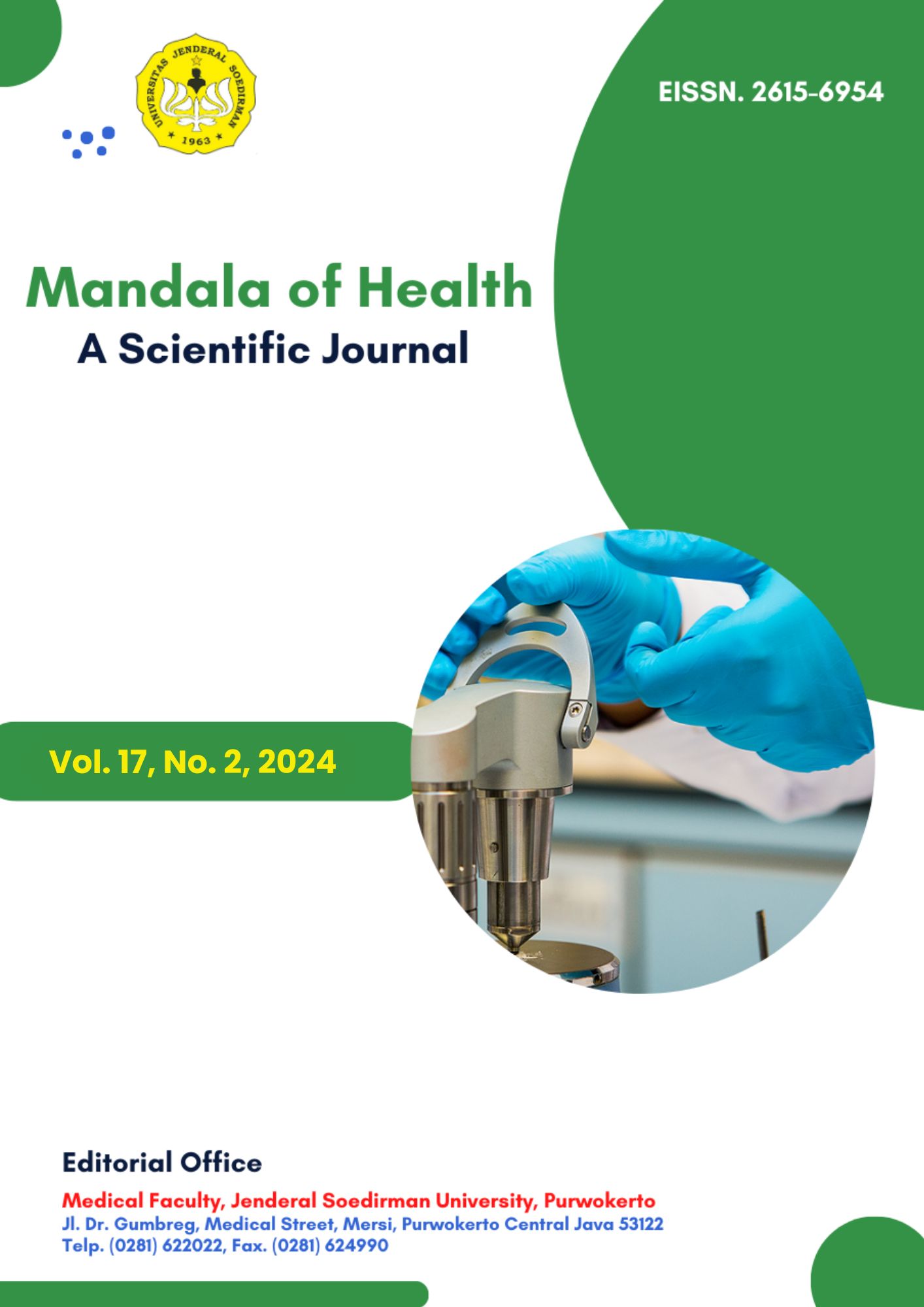EFEK EKSTRAK DAUN KEMANGI (Ocimum basilicum L.) TERHADAP KADAR HIGH-DENSITY LIPOPROTEIN TIKUS (Rattus norvegicus) MODEL ATEROSKLEROSIS
Abstract
Atherosclerosis is the cardiovascular disease’s main pathological mechanism. Basil leaves are food companion that s widely consumed by Indonesians and contains phenolic and flavonoid bioactive compounds that can increase HDL levels. The purpose of this study was to see the effect of basil leaves extract (Ocimum basilicum L.) on HDL levels in atherosclerosis model rat. This study was conducted using the post test only control group design method on 29 rats. The rats were divided into 5 groups, K-, K+, P1, P2, and P3. K- is group of rats without treatment. K+ was treated with partial carotid ligation (PCL) and high fat diet (HFD), P1 was treated with PCL, HFD and given a dose of 100 mg/kgB basil leaves extract, P2 was treated with PCL, HFD and given a dose of 200 mg/kgBB basil leaves extract, P3 was treated with PCL, HFD and given simvastatin 1.5 mg/rat/day. HFD was given for 7 days, basil leaves extract and simvastatin given for 14 days using oral feeding tube. HDL levels tested with CHOD-PAP method using a microlab 300 spectrophotometer. The result from this study were analyzed by Saphiro-Wilk test, and Kruskal-Wallis test. The mean HDL levels obtained in the K- group were 52,65(49,70‒68.10) mg/dL, K+ 49,67±8,77 mg/dL, P1 52.70±1.58 mg/dL, P2 54.40±9.94 mg/dL, P3 58,05 ±5,34 mg/dL. The results showed there was a non-significant increase in HDL levels (p=0.377) in atherosclerosis model rat by giving basil leaves extract on both dose, and simvastatin.
References
Amrani, S., Harnafi, H., Bouanani, N.E.H., Aziz, M., Caid, H., Manfredini, S., et al. 2006. Hypolipidaemic activity of aqueous Ocimum basilicum extract in acute hyperlipidaemia induced by triton wr-1339 in rats and its antioxidant property. Phyther Res 22(4):544–9. World Health Organization (WHO). 2021. Cardiovascular diseases (CVDs). Available from: https://www.who.int/news-room/fact-sheets/detail/cardiovascular-diseases-(cvds)
Arnett, D.K., Blumenthal, R.S., Albert, M.A., Buroker, A.B,, Goldberger, Z.D., Hahn, E.J., et al. 2019. 2019 ACC/AHA Guideline on the primary prevention of cardiovascular disease: executive summary: a report of the american college of cardiology/american heart association task force on clinical practice guidelines. J Am Coll Cardiol 74(10):1376–414.
Badan Penelitian dan Pengembangan Kesehatan. 2019. Laporan nasional riset kesehatan dasar 2018. Jakarta; Kemenkes.
Doloksaribu, L.G. 2021. Asupan lemak kaitannya dengan kadar high density lipoprotein (HDL) dan kadar low density lipoprotein pada ibu persit kartika chandra kirana bukit barisan kecamatan galang. Jurnal Gizi 10(2).
Fitriani, D., Hasbie, N.F., Rahmah, Dermawan, A.K. 2021. Studi literatur pengaruh pemberian ekstrak kemangi (Ocimum basilicum l.) terhadap kadar HDL pada tikus putih (Rattus norvegicus) jantan galur wistar yang diberi diet tinggi lemak. Jurn IKK;8(4) 173-77.
Golforoush, P., Yellon, D.M., Davidson, S.M. 2020. Mouse models of atherosclerosis and their suitability for the study of myocardial infarction. Basic Res Cardiol 30;115(6):73-9.
Harini, M., Astirin, O.P. 2009. Blood cholesterol levels of hypercholesterolemic rat (Rattus norvegicus) after vco treatment. Nusantara Bio 1;53-8.
Harnafi, H., Aziz, M., Amrani, S. 2013. Sweet basil (Ocimum basilicum) improves lipid metabolism in hypercholesterolemic rats. Clinical Nutrition ESPEN 4(4): 181-86.
Harsa, I.M.S. 2014. Efek pemberian diet tinggi lemak terhadap profil lemak darah tikus putih (rattus norvegicus). Jurnal Ilmiah Kedokteran 3(1):1-7.
Huang, C., Zhang, J., Huang, J., Li, H., Wen, K., Bao, J., et al. 2023. Proteomic and functional analysis of HDL subclasses in humans and rats: a proof-of-concept study. Lipids Health Dis 1;22(1):86-9.
Hunninghake, D.B., Knopp, R.H., Schonfeld, G., et al. 2009. Efficacy and safety of pravastatin in patients with primary hypercholesterolemia. I. A dose–response study. Atherosclerosis 85:81–89.
Ilyas, I., Little, P.J., Liu, Z., Xu, Y., Kamato, D., Berk, B.C., et al. 2022. Mouse models of atherosclerosis in translational research. Trends Pharmacol Sci 1;43(11):920–39.
Lina, M., Kumalasari, F., Andiarna, F. 2020. Uji fitokimia ekstrak etanol daun kemangi (ocimum basilicum l). Indones J Heal Sci 4(1):39–44.
Merino, H., Parthasarathy, S., Singla, D.K. 2013. Partial ligation-induced carotid artery occlusion induces leukocyte recruitment and lipid accumulation-A shear stress model of atherosclerosis. Mol Cell Biochem 372(1–2):267–73.
Nahal, D.E., Hala, T., Sayed, F. 2012. Study the impact of sweet basil extracts (Ocimum basilicum) to reduce blood cholesterol. Egyptian Journal of Nutrition and Health 7(1): 51-68.
Nakagawa, K., Nakashima, Y. 2018. Pathologic intimal thickening in human atherosclerosis is formed by extracellular accumulation of plasma-derived lipids and dispersion of intimal smooth muscle cells. Atherosclerosis 1;274:235–42.
Perhimpunan Dokter Spesialis Kardiovaskular Indonesia (PERKI). 2013. Pedoman tatalaksana dislipidemia. Jakarta. Centra Communications.
Ridha, H. 2020. Pengaruh pemberian ekstrak kemangi (ocimum basilicum l.) terhadap profil lipid pada tikus model diabetes gestasional. Skripsi. Padang: Fakultas Kedokteran Universitas Andalas.
Riesanti, D. 2014. Kadar hdl, kadar ldl dan gambaran histopatologi aorta pada hewan model tikus (rattus norvegicus) hiperkolesterolemia dengan terapi ekstrak air benalu mangga (dendrophthoe pentandra). Skripsi. Fakultas Kedokteran Hewan Universitas Brawijaya, Malang.
Sherwood, L. 2016 Human physiology. 9th Edition. United States: Cengage Learning; 327–28.
Shinohata, R., Shibakura, M., Arao, Y., Watanabe, S., Hirohata, S., Usui, S. 2022. A high-fat/high-cholesterol diet, but not high-cholesterol alone, increases free cholesterol and apoE-rich HDL serum levels in rats and upregulates hepatic ABCA1 expression. Biochimie 1;197:49–58.
Touiss, I., Harnafi, M., Bekkouch, O., Ouguerram, K., Amrani, S. 2020. Rosmarinic acid-rich extract from Ocimum basilicum L. decreases hyperlipidemia in high fat diet-induced hyperlipidemic mice and prevents plasma lipid oxidation. Physiol Pharmacol 23:197-207.
Vogiatzi, G., Tousoulis, D., Stefanadis, C. 2022. The role of oxidative stress in atherosclerosis. Hellenic J cardiol 50(5):402-9.
Willerson J.T, Cohn JN, Wellens HJJ, Holmes Jr DR. 2007. Cardiovascular medicine. Third Edition. London: Springer;(3):621–22.

This work is licensed under a Creative Commons Attribution-NonCommercial-ShareAlike 4.0 International License.







